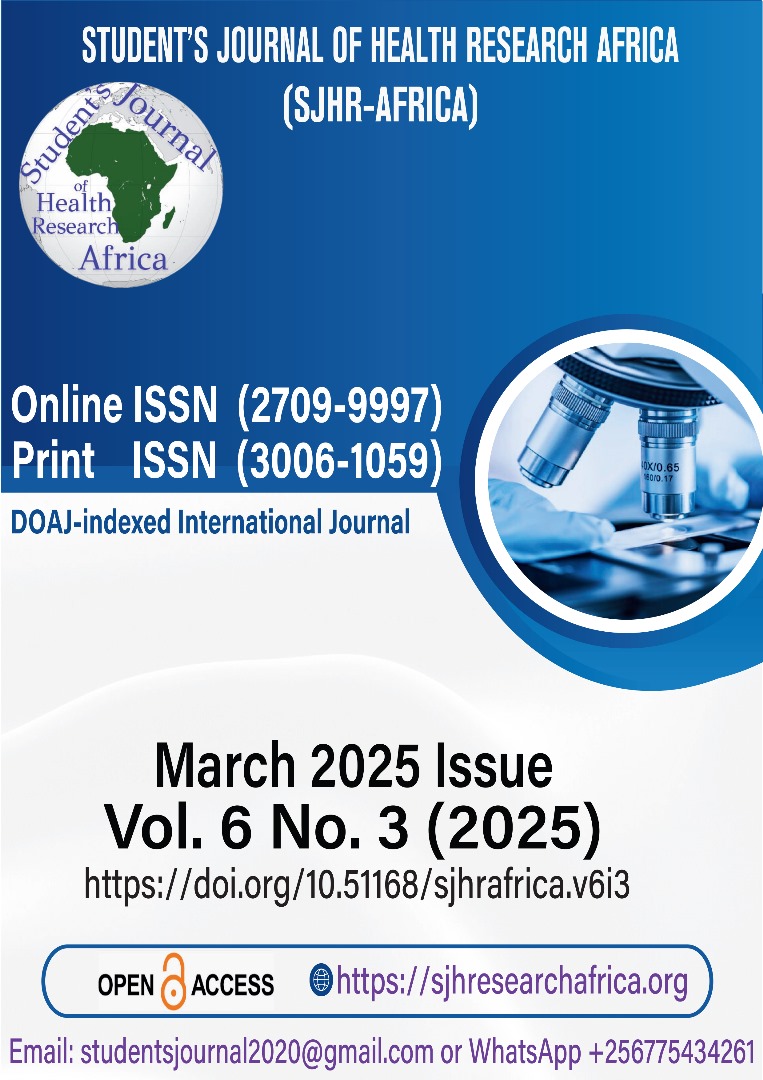A COMPARATIVE ANALYSIS OF PAP SMEAR AND COLPOSCOPIC FINDINGS IN INDIVIDUALS PRESENTING WITH VAGINAL DISCHARGE AT A TERTIARY CARE OUTPATIENT DEPARTMENT: A CROSS-SECTIONAL STUDY.
DOI:
https://doi.org/10.51168/sjhrafrica.v6i3.1672Keywords:
Cervical cancer screening, Pap smear, colposcopy, precancerous lesions, cervical intraepithelial neoplasiaAbstract
Background
Cervical cancer is a predominant cause of cancer-related mortality in women globally. Screening techniques, such as Pap smear and colposcopy, are essential for detecting precancerous lesions, facilitating prompt intervention, and alleviating the disease burden.
Methods
This cross-sectional study was conducted in the Obstetrics and Gynaecology Department, Sri Krishna Medical College and Hospital, Muzaffarpur, Bihar, over one year. A total of 250 women aged 35–55 years underwent Pap smear, colposcopy, and biopsy for cervical lesion assessment.
Results
Among the participants, 34.0% had high-grade squamous intraepithelial lesions (HSIL), 22.4% had low-grade squamous intraepithelial lesions (LSIL), and 21.2% showed inflammatory changes on Pap smear. Colposcopy revealed CIN I in 48.0% of cases, CIN II–III in 36.4%, and CIN III in 15.6%. Histopathological confirmation showed 83.2% had precancerous lesions, with 7.2% diagnosed with squamous cell carcinoma and 1.2% with adenocarcinoma. Among the total study population (n = 250), 83.2% (208 patients) had abnormal findings suggestive of precancerous or cancerous cervical lesions, while 16.8% (42 patients) showed normal or non-precancerous findings. This corresponds to a prevalence of abnormal cervical pathology of 83.2% in the present study cohort. The study demonstrated that combining Pap smear screening with colposcopic evaluation and targeted biopsy significantly improved early detection of precancerous cervical lesions. This integrated diagnostic approach enabled timely intervention, reducing the risk of progression to invasive cancer.
Conclusion
The study highlights the high prevalence of precancerous cervical lesions, emphasizing the necessity of early screening. Colposcopy demonstrated higher diagnostic accuracy than Pap smear, reinforcing its role in early cervical cancer detection.
References
Comprehensive cervical cancer prevention and control: a healthier future for girls and women WHO GUIDANCE NOTE [Internet]. Available from: https://iris.who.int/bitstream/handle/10665/78128/9789241505147_eng.pdf
Jones, Howard W., III, and Rock, John A. Te Linde's Operative Gynecology, 11e. Lippincott Williams & Wilkins, a Wolters Kluwer brand, 2015. https://obgyn.lwwhealthlibrary.com/book.aspx?bookid=2242§ionid=0
Adelman MR. Novel advancements in colposcopy: historical perspectives and a systematic review of future developments. J Low Genit Tract Dis. 2014 Jul;18(3):246-60. https://doi.org/10.1097/LGT.0b013e3182a72170
Ren H, Jia M, Zhao S, Li H, Fan S. Factors Correlated with the Accuracy of Colposcopy-Directed Biopsy: A Systematic Review and Meta-analysis. J Invest Surg. 2022 Feb;35(2):284-292. https://doi.org/10.1080/08941939.2020.1850944
Reagan Jw, Seidemann Il, Saracusa Y. The cellular morphology of carcinoma in situ and dysplasia or atypical hyperplasia of the uterine cervix. Cancer. 1953 Mar;6(2):224-34. doi: 10.1002/1097-0142(195303)6:2<224::aid-cncr2820060203>3.0.co;2-h. PMID: 13032911.
https://doi.org/10.1002/1097-0142(195303)6:2<224::AID-CNCR2820060203>3.0.CO;2-H
Raychaudhuri S, Mandal S. Current status of knowledge, attitude, and practice (KAP) and screening for cervical cancer in countries at different levels of development. Asian Pac J Cancer Prev. 2012;13(9):4221-7. https://doi.org/10.7314/APJCP.2012.13.9.4221
Miller AB, Sankaranarayanan R, Bosch FX, Sepulveda C. Can screening for cervical cancer be improved, especially in developing countries? Int J Cancer. 2003 Nov 10;107(3):337-40. https://doi.org/10.1002/ijc.11388
Kalliala I, Athanasiou A, Veronika AA, Salanti G, Efthimiou O, Raftis N, Bowden S, Paraskevaidi M, Aro K, Arbyn M, Bennett P, Nieminen P, Paraskevaidis E, Kyrgiou M. Incidence and mortality from cervical cancer and other malignancies after treatment of cervical intraepithelial neoplasia: a systematic review and meta-analysis of the literature. Ann Oncol. 2020 Feb;31(2):213-227. https://doi.org/10.1016/j.annonc.2019.11.004
Dhaubhadel P, Vaidya A, Choudhary P. Early detection of precursors of cervical cancer with cervical cytology and visual inspection of the cervix with acetic Acid. JNMA J Nepal Med Assoc. 2008 Apr-Jun;47(170):71-6. PMID: 18709035.https://doi.org/10.31729/jnma.316
Shalini R, Amita S, Neera MA. How alarming is post-coital bleeding--a cytologic, colposcopic, and histopathologic evaluation? Gynecol Obstet Invest. 1998;45(3):205-8.https://doi.org/10.1159/000009957
Mhaske M, Jawadekar SJ, Saundale SG. Study of the association of some risk factors & cervical dysplasia/cancer among rural women. National Journal of Community Medicine. 2011;2(2):209-12. pISSN: 0976 3325 eISSN: 2229 6816
Stern E. Epidemiology of dysplasia. Obstet Gynecol Surv. 1969 Jul;24(7 Pt 2):711-23. https://doi.org/10.1097/00006254-196907001-00005
Wright TC Jr, Cox JT, Massad LS, Twiggs LB, Wilkinson EJ; ASCCP-Sponsored Consensus Conference. 2001 Consensus Guidelines for the management of women with cervical cytological abnormalities. JAMA. 2002 Apr 24;287(16):2120-9. https://doi.org/10.1001/jama.287.16.2120
Olaniyan OB. Validity of colposcopy in the diagnosis of early cervical neoplasia--a review. Afr J Reprod Health. 2002 Dec;6(3):59-69. PMID: 12685410. https://doi.org/10.2307/3583258
Downloads
Published
How to Cite
Issue
Section
License
Copyright (c) 2025 Punita Kumari, Rajeev Kumar Khetan, Pratima

This work is licensed under a Creative Commons Attribution-NonCommercial-NoDerivatives 4.0 International License.






















